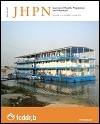White Rice Consumption and CVD Risk Factors among Iranian Population
DOI:
https://doi.org/10.3329/jhpn.v31i2.16390Keywords:
Cardiovascular diseases, Diet, Risk factors, White rice, IranAbstract
Association between white rice intake and risk factors of cardiovascular diseases remained uncertain. Most of the previous published studies have been done in western countries with different lifestyles, and scant data are available from the Middle East region, including Iran. This cross-sectional study was conducted in the structure of Isfahan Healthy Heart Program (IHHP) to assess the association between white rice consumption and risk factors of cardiovascular diseases. In the present study, 3,006 men were included from three counties of Isfahan, Najafabad, and Arak by multistage cluster random-sampling method. Dietary intake was assessed with a 49-item food frequency questionnaire (FFQ). Laboratory assessment was done in a standardized central laboratory. Outcome variables were fasting blood glucose, serum lipid levels, and anthropometric variables. Socioeconomic and demographic data, physical activity, and body mass index (BMI) were considered covariates and were adjusted in analysis. In this study, Students t-test, chi-square test, and logistic regression were used for statistical analyses. Means of BMI among those subjects who consumed white rice less than 7 times per week and people who consumed 7-14 times per week were almost similar24.8±4.3 vs 24.5±4.7 kg/m2. There was no significant association between white rice consumption and risk factors of cardiovascular diseases, such as fasting blood sugar and serum lipid profiles. Although whole grain consumption has undeniable effect on preventing cardiovascular disease risk, white rice consumption was not associated with cardiovascular risks among Iranian men in the present study. Further prospective studies with a semi-quantitative FFQ or dietary record questionnaire, representing type and portion-size of rice intake as well as cooking methods and other foods consumed with rice that affect glycaemic index (GI) of rice, are required to support our finding and to illustrate the probable mechanism.
J HEALTH POPUL NUTR 2013 Jun; 31(2): 252-261
Downloads
1356
726

